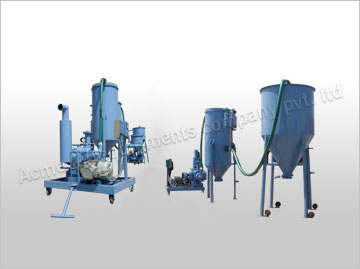Table of Contents
In the realm of bulk material handling, pneumatic conveying systems are widely valued for their closed-loop design, cleanliness and flexibility. Yet, they often face challenges related to dust control, material retention, contamination and process efficiency – issues that vary significantly by industry and conveyed material.
Two critical technologies that address these challenges are cyclones and filters. Properly selected and integrated, these components enhance the performance and adaptability of pneumatic conveying equipment across diverse sectors – from pharmaceuticals to food, plastics to chemicals. This article explores how cyclones and filters are engineered within pneumatic conveyors to mitigate material-specific issues, ensuring reliable and compliant operation.
Cyclones in Pneumatic Conveyors: Addressing Particle Separation and Overload
Cyclones or centrifugal separators, are one of the first lines of defence in a pneumatic material handling system. Positioned after the conveyance line and before air exhaust or further filtration, their main function is to remove heavier or coarser particles from the airflow using centrifugal force.
How Cyclones Solve Industry-Specific Challenges?
- In the Plastics Industry: Cyclones separate plastic pellets from conveying air with
minimal degradation, preserving material shape. - In Food Processing: Prevents sticky or dense granules like sugar or flour from
contaminating downstream filters or re-entering air circulation. - In Cement Industry: They reduce the abrasive impact of aluminium, silica, lime or clinker particles by capturing them before they cause equipment wear.

Cyclones are essential in preventing overloading of filters, reducing maintenance frequency and handling large volumes without mechanical contact or filter clogging.
Filters in Pneumatic Conveying: Ensuring Air Quality and Contaminant Control
Filters complement cyclones by capturing the fine particles that escape centrifugal separation. These particles pose risks in sensitive production environments, particularly where hygiene, safety or product integrity are paramount.
How Filters Resolve Material-Specific Issues?
- Food and Spices: Protects against cross-contamination by capturing residual aromatic or allergenic dust.
- Powder Coatings or Chemicals: Prevents fine, volatile particles from escaping into the facility air or compromising subsequent batches.
Filters are often selected based on permeability, particle retention efficiency and compatibility with cleaning systems, ensuring that the pneumatic conveyor system operates without compromising downstream purity or system performance.
Material-Specific Behavior and Component Selection
The combination of cyclones and filters must be tailored to the physical behavior of the conveyed material. Factors such as particle size, shape, flowability and moisture content directly influence component sizing and system design.
Examples of Application-Specific Design Choices:
- Hygroscopic Materials: May clump in humid environments, requiring pre-filter heating and hydrophobic filter media.
- Fibrous or Flaky Materials (e.g. plastics): Often bypass cyclones; thus, multi-stage filters or larger surface area elements are needed.
- Fine Powders: Require dual-stage filtration with pre-separators and high-efficiency final filters.
At Acme Air Equipments Private Limited, as a leading manufacturer of pneumatic conveying system must analyse the conveyed media to determine the right cyclone geometry, dust loading rates and filter media specifications.
Integration Strategies: Aligning Cyclones and Filters for Peak Efficiency
To optimize system performance, pneumatic material conveying systems must coordinate the roles of cyclones and filters – avoiding redundancy while ensuring comprehensive particulate removal.
Effective Integration Practices:
- Series Configuration: Cyclones positioned upstream of filters extend filter lifespan and reduce differential pressure.
- Pulse-Cleaned Filters: Ideal in continuous processes with high dust load where manual filter maintenance is impractical.
- Modular Assemblies: Allow flexible installation and easier maintenance scheduling for both cyclones and filters.
Proper integration ensures clean discharge air, reduces emissions and improves uptime across the system.
System Design: Engineering for Longevity
When designing a pneumatic vacuum conveying system, incorporating the right separation elements ensures the system not only runs efficiently but also complies with environmental and safety standards.
Design Recommendations:
- Use cyclones with wear-resistant liners for abrasive materials.
- Select filters rated for high dust-holding capacity to minimize change-outs.
- Monitor pressure drops across filters to signal maintenance needs.
- Employ differential pressure sensors and alarms in critical hygiene zones.
Well-engineered systems help in maintaining operational excellence, even in processes where particle control is non-negotiable.
Conclusion
In every industrial environment – from cleanrooms to foundries – cyclones and filters serve as the backbone of efficient pneumatic conveying systems. By resolving material-specific challenges such as dust containment, particle recovery, contamination prevention and equipment wear, these components transform a standard conveyance setup into a performance-optimized solution.
When tailored to the process, material properties and operating conditions, cyclones and filters not only protect the product and the process but also deliver longer service life and reduced operational costs.
FAQs About Pneumatic Conveying Systems
Why are cyclones important in pneumatic conveying systems?
They remove bulkier, denser particles using centrifugal force, protecting filters and reducing system wear.
What type of filter is best for food-grade pneumatic conveying?
High-efficiency, food-safe filters with anti-static or hydrophobic coatings are preferred for hygiene and safety.
Can cyclones and filters handle very fine powders?
Yes, when combined - cyclones remove coarse material and filters trap fine particles that would otherwise escape.
How do cyclones and filters help in abrasive material conveying?
Cyclones reduce direct contact between abrasives and machines, filters prevent fine dust from damaging sensitive components.
About Author

CEO
Mr. Vishwesh Pardeshi is the CEO of Acme Air Equipments Company Pvt. Ltd., an industrial and engineering goods manufacturing company based in Ahmedabad, Gujarat (India). He has taken over the responsibility from founding Partners and Directors of the Company, and is now leading a talented group of professionals since 2020 by bringing in vast industrial and management expertise. By qualification, he holds a Bachelor Degree in Mechanical Engineering and also holds a MBA degree from reputed institutes. Under his leadership, the Company has successfully executed prestigious projects by delivering high quality and world class products from a state of the art manufacturing facility which combines CNC-enabled precision manufacturing and strong after sales support. In line with the Vision, Mission and Core Values of the Organization, Mr. Vishwesh Pardeshi continues to drive Quality, Reliability and Global Expansion at Acme Air Equipments Co. Pvt. Ltd.









